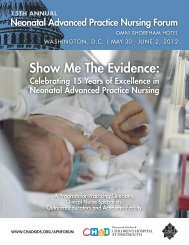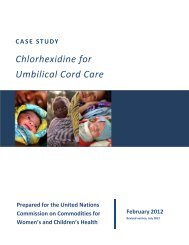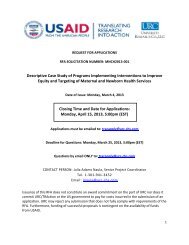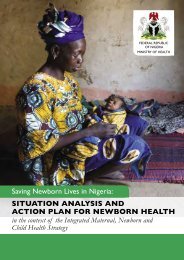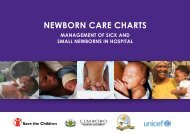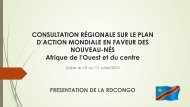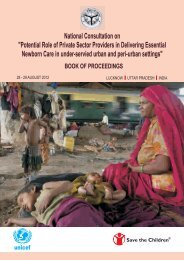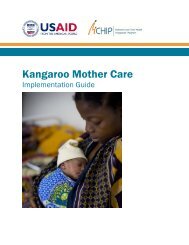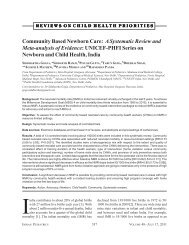Kangaroo Mother Care Policy/Guidelines - Western Cape Government
Kangaroo Mother Care Policy/Guidelines - Western Cape Government
Kangaroo Mother Care Policy/Guidelines - Western Cape Government
Create successful ePaper yourself
Turn your PDF publications into a flip-book with our unique Google optimized e-Paper software.
<strong>Kangaroo</strong> <strong>Mother</strong> <strong>Care</strong> (KMCI Policv and <strong>Guidelines</strong> for<br />
the <strong>Western</strong> <strong>Cape</strong> Province.<br />
Compiled by the <strong>Kangaroo</strong> <strong>Mother</strong> <strong>Care</strong> Provincial Task Team<br />
I.<br />
1.1.<br />
1.2.<br />
1.3.<br />
1.4.<br />
1.5.<br />
1.6.<br />
1.7.<br />
Introduction<br />
Definitions and abbreviations.<br />
<strong>Policy</strong> development.<br />
Disclaimer.<br />
Origins of KMC.<br />
How to do KMC.<br />
Benefits of KMC.<br />
KMC in different contexts.<br />
2.<br />
Vision and Mission<br />
3.<br />
3.1.<br />
3.2.<br />
3.3.<br />
3.4.<br />
3.5.<br />
3.6.<br />
3.7.<br />
3.8, ,<br />
3.9.<br />
4.<br />
Objectives<br />
To change attitudes about the way in which LBW infants and their mothers are<br />
managed.<br />
To promote the training of health care workers in KMC.<br />
To make the public aware of KMC and its benefits.<br />
To establish KMC as a safe and effective method of care for LBW infants<br />
at all levels of health care throughout the <strong>Western</strong> <strong>Cape</strong> Province.<br />
To set guidelines for the use of KMC in health care facilities.<br />
To set guidelines for transporting LBW infants in KMC.<br />
To establish criteria and facilities for follow up of babies in KMC.<br />
To promote evaluation and monitoring of all aspects of KMC.<br />
To provide a forum for discussion on and support of KMC.<br />
Resources required for implementation of KMC<br />
-<br />
4.1. Budget<br />
4.2. Health Promotion and Marketing<br />
4.3. Training<br />
4.4. Personnel<br />
4.5. Building and furnishing<br />
4.6. Pharmacy<br />
4.7. Housekeeping<br />
4.8. F~lloW-Up<br />
4.9. Transport<br />
4.10. Health Information<br />
4.11. Support<br />
KMC <strong>Policy</strong> and <strong>Guidelines</strong> for the <strong>Western</strong> <strong>Cape</strong> Province.<br />
. .<br />
. .-
1. introduction<br />
1.1 Definitions and abbreviations<br />
1.1.1. KMC - is an intervention for the care of the low birth weight (LBW) infant. It consists of four<br />
components:<br />
I .l.l.l.<strong>Kangaroo</strong> position<br />
Stable LBW infants are nursed skin-to-skin between their mother's breasts.<br />
Skin-to-skin care may be intermittent at first, but should gradually become<br />
continuous and persist until the infant weighs at least 2OOOg.<br />
1.1.1.2. <strong>Kangaroo</strong> nutrition<br />
Infants should be fed own mother's milk, either by breastfeeding on demand<br />
or by expressed breastmilk via naso-gastric tube or cup.<br />
1.1.1.3. <strong>Kangaroo</strong> support<br />
Support of the mother-infant dyad, both in hospital and at home after<br />
discharge, for optimal outcome. This will always depend on the context and<br />
should be a dynamic process of development and improvement.<br />
1.1.1.4. <strong>Kangaroo</strong> discharge<br />
Infants may be discharged from hospital in the kangaroo position at any -<br />
weight or gestational age, provided they are well and gaining weight on<br />
mother's milk and that there are adequate follow-up facilities and support.<br />
1.1.2. Dyad - the mother and infant together are seen as a single unit<br />
1.1.3. IPPV - intermittent positive pressure ventilation.<br />
1.1.4. LBW - low birth weight. Infants with birth mass less than 25009<br />
1.1.5. NlCU -Neonatal Intensive <strong>Care</strong> Unit<br />
1.1.6. MCWH - Maternal, Child and Women's Health<br />
1.1.7. MOU - Midwife Obstetric Unit. Birthing - unit, run by midwives, in the community for level one<br />
patients.<br />
KMC <strong>Policy</strong> and <strong>Guidelines</strong> for the <strong>Western</strong> <strong>Cape</strong> Province.<br />
. .<br />
2
1.2. <strong>Policy</strong> Development<br />
1.2.1 With increasing costs and rationalization in all sectors of health care in South Africa it has<br />
become necessary to find and implement efficient and cost effective ways of caring for our<br />
patients. KMC has been shown to be a safe effective and affordable method of caring for<br />
LBW infants in many contexts around the world, in our own country and in our own province.<br />
1.2.2. The KMC <strong>Policy</strong> and <strong>Guidelines</strong> for the <strong>Western</strong> <strong>Cape</strong> Province has been developed under<br />
the auspices of the MCWH Sub-directorate in conjunction with the Provincial KMC Task<br />
Team. The <strong>Policy</strong> and <strong>Guidelines</strong> are aimed at all health care workers including, doctors,<br />
nurses, occupational therapists, physiotherapists, nutritionists, social workers, policy makers<br />
and managers.<br />
1.2.3. The development has been a consultative process with several draft versions being<br />
distributed to the regionsldistricts for comment and revision. On completion the policy will be<br />
distributed to the four regional offices. private and provincial hospitals and health care<br />
facilities, district health services, NGO's. CBOs and other role-players for implementation<br />
and support. Other services and directorates such as Support Services, Human Resource<br />
Development, Health Information. Nutrition and Mental Health, have been, or will be,<br />
consulted and involved in the implementation process.<br />
1.2.4. The mechanisms for feedback to the PAWC KMC Task Team are set out in the <strong>Policy</strong>.<br />
1.3. Disclaimer<br />
1.3.1 The <strong>Policy</strong> and <strong>Guidelines</strong> are presented as safe standard practice and statements made are<br />
supported by references available from KMC Interest Group (see paragraph 4. 2.4.). The<br />
safety of the infant should be of paramount importance and the practice of KMC should be in<br />
line with all other policies and developments.<br />
1.3.2. The policy and guidelines are not seen as finite. but rather as undergoing continual evolution<br />
and refinement with time and experience. The mechanisms for feedback to the PAWC Task<br />
Team are set out in the policy.<br />
1.3.3.<br />
1.4. Origins of KMC<br />
The Department accepts no liability for any damages or loss recognized by law that may be<br />
suffered as a result of the incorrect usage of the methods promoted in the policy.<br />
-<br />
1.4.1. Although women of many cultures have carried their infants against their breasts for<br />
centuries, KMC as described above was 'rediscovered in Bogota, Colombia in the 1970s in<br />
response to shortages of people power and other resources in hospitals there. Drs Rey and<br />
Martinez developed KMC as a method of ambulatory care for low birth weight infants in their<br />
hospital where there had been high morbidity and mortality among these infants due to<br />
overcrowding and sepsis. As soon as the infants are stable and the mothers trained in the<br />
KMC method, the infants are sent home, irrespective of weight or gestational age, carried<br />
between their mothers' breasts at all times and fed only mothers' milk. They are followed Up<br />
at a special KMC clinic.<br />
1.4.2<br />
The dramatic improvement in the outcome of the Bogota patients prompted investigation<br />
from the WHOlUNlCEF and soon North American. European and other health services<br />
around the world were putting KMC into practice in addition to, and in some instances<br />
instead of, their conventional methods of LBW infant care. Numerous studies have show<br />
KMC to be a safe and effective method of caring for these infants.<br />
KMC <strong>Policy</strong> and <strong>Guidelines</strong> for the <strong>Western</strong> <strong>Cape</strong> Province.<br />
3
1.5. How to do KMC<br />
1.5.1. <strong>Kangaroo</strong> position<br />
1.5.1.1. KMC should start. irrespective of gestational age or weight, as soon as the baby is<br />
stable and in 40% (or less) head-box oxygen. KMC may be practiced continuously or<br />
intermittently. Non-resident mothers should practice KMC throughout every visit i.e.<br />
intermittent KMC.<br />
1.5.1.2.The baby is dressed in a nappy and a cap and placed in an upright position against<br />
the mother's bare chest, between her breasts and inside her blouse. Both mother<br />
and baby may be covered with a blanket or jacket if it is cold. The mother should<br />
wear a button down top and she should tie the top under the baby's bottom or tuck it<br />
into the waistband of her skirt or slacks so that her baby is secure and does not slip<br />
out! This method is usually adequate for KMC.<br />
1.5.1.3.Special tops may have the disadvantage of introducing the idea that KMC cannot be<br />
done unless a custom made garment is worn, but a simple 'Boob-tube" of cotton/<br />
lycra is inexpensive and comfortable for both mother and baby. The mother should<br />
be encouraged to make, bring or wear whatever suitable garment she can affoid.<br />
1.5.1.4. Fathers, grandparents or any other responsible adult of the mother's choice may<br />
also do KMC with the baby if the mother is unable to do KMC, or if she needs to be<br />
relieved for a while. These support KMC givers, especially the father, should be<br />
involved in KMC training as early as possible, together with the mother, while the<br />
infant is still in the Neonatal Unit.<br />
1.5.2. <strong>Kangaroo</strong> nutrition<br />
1.5.2.l.The baby should be allowed to breast feed freely. Adequate and regular feeding is<br />
essential, particularly at night. Infants under 15009 should be fed at least every two<br />
hours and infants over 15009 at least every three hours. Breast milk should be the<br />
first. second and third choice: it is cost effective to admit mothers for this reason<br />
alone. Babies who are not gaining weight adequately should receive a breast milk<br />
fortifier, which supplies extra protein, calories and phosphate.<br />
1.5.2.2.With early and continuous skin-to-skin contact, even infants of 30 weeks gestation<br />
are able to breastfeed exclusively. Babies who are unable to suckle may be fed<br />
expressed breast milk via a naso-gastric tube or cup. Babies should remain in the<br />
<strong>Kangaroo</strong> Position while receiving a tube feed and the mothers should hold the<br />
feeding funnel. The mother may adjust the position of the baby to breast- or cupfeed.<br />
Babies should NOT be fed in incubators, cribs or cots while mothers are<br />
visiting.<br />
1.5.2.3.1f breast milk is insufficient, or breastfeeding inadvisable, formula may be added or<br />
substituted. <strong>Mother</strong>s who are HIV positive should be counselled about feeding their<br />
infants according to their circumstances, current scientific information and current<br />
policies.<br />
1.5.3. <strong>Kangaroo</strong> support<br />
1.5.3.1.The mother should have the concept of KMC explained and demonstrated to her in<br />
the antenatal clinic. The explanations and demonstrations should continue after the<br />
baby is born until the mother is motivated and able to put the baby in the <strong>Kangaroo</strong><br />
Position by herself and to breastfeed. Staff at all levels of neonatal care should be<br />
able to educate parents about KMC. to assist them with positioning of the infant,<br />
drips, oxygen tubing, feeding, and to discuss any queries they might have.<br />
<strong>Mother</strong>s need strong emotional support and practical guidelines for prolonged KMC,<br />
(say in the absence of incubators).<br />
KMC <strong>Policy</strong> and <strong>Guidelines</strong> for the <strong>Western</strong> <strong>Cape</strong> Province.<br />
4
1.5.3.2. One of the most cost-effective methods of providing support to the mother-infant<br />
dyad is to establish a dedicated KMC Ward where the mother and her baby can live<br />
together while doing KMC 24 hours per day prior to discharge from hospital. Here<br />
the mother should be responsible for her baby under the supervision of a nurse. She<br />
should be shown the KMC Ward and informed of what is expected of her while she<br />
is there and what she should bring with her. The KMC Ward should be as<br />
comfortable as possible and have a homely rather than a hospital atmosphere.<br />
1.5.3.3. The baby may be transferred to the KMC Ward with the mother if the baby is well.<br />
growing satisfactorily and is at least partially breastfed (or cup-fed if breastfeeding is<br />
not possible). The mother should have been trained in <strong>Kangaroo</strong> Position and<br />
Nutrition. The professional nurse in charge of the unit may approve the transfer in<br />
consultation with the doctor. The baby should be signed out in the folder in the same<br />
way as any other in-house transfer in the hospital or clinic.<br />
1.5.3.4. In the KMC Ward the baby will be in the <strong>Kangaroo</strong> Position all the time i.e.<br />
continuous KMC. The mother should be encouraged to wear her day clothes rather<br />
than a nightdress or hospital gown. She should be mobile in preparation for doing<br />
her household chores with her baby in the <strong>Kangaroo</strong> Position at home. There should<br />
be no cribs or cots in the KMC Ward. When the mother goes to the bathroom the<br />
baby should be placed safely on her bed and the nurse informed. The baby should<br />
never be given to a stranger to hold.<br />
1.5.3.5. Some special babies or mothers with problems may benefit from spending time in<br />
the KMC Ward, but may not be able to cope without nursing supervision. Where<br />
there is no 24-hour nursing supervision in the KMC Ward, these babies should be<br />
transferred back into the neonatal unit at night.<br />
1.5.3.6. The KMC Ward should be used as a venue for education and empowerment of<br />
mothers of LBW infants. Short lectures and informal discussion on KMC, mother<br />
craft, infant and child health topics should be instituted and mothers who are visiting<br />
their babies in the neonatal unit should be included.<br />
1.5.4. <strong>Kangaroo</strong> discharge<br />
1.5.4.1. Discharge plans should be discussed with the parents from the start of KMC! The<br />
baby will need to be in the <strong>Kangaroo</strong> Position 24 hours a day from the time helshe<br />
comes out of the incubator until helshe weighs at least 2kg. That means KMC at<br />
home 24 hours a day after discharge. If the mother needs a break the father or<br />
other responsible adult may relieve her for a while until the next breastfeed. The<br />
mother may also need a caretaker for her baby if she has to go back to work or<br />
school, in which case the father, granny or other caretaker may take over. These<br />
support KMC givers, especially the father, should be involved in KMC training as<br />
early as possible with the mother and while the infant is still in the Neonatal Unit.<br />
1.5.4.2.The baby is discharged provided that he is well, gaining at least 159 per day, is<br />
feeding adequately on the breast or by cup and that the mother is confident in<br />
hindling and is committed to doing KMC at home. However if the mother or baby<br />
do not fulfil the discharge criteria the discharge is delayed irrespective of the baby's<br />
weight. The weight at discharge depends on the baby's wellbeing, the mother's<br />
maturity and socio-economic standing and access to follow-up facilities.<br />
1.5.4.3.The infants should be discharged at a weight appropriate to the follow up care that<br />
health care services in that specific area are able to provide i.e. the better the<br />
follow-up facilities, the earlier the infant may be discharged.<br />
KMC <strong>Policy</strong> and <strong>Guidelines</strong> for the <strong>Western</strong> <strong>Cape</strong> Province.<br />
5
1.5.4.4. After discharge infants should be seen frequently for weight checks. The smaller<br />
infants, less than 18OOg. should be seen daily, whereas those over 18009 may be<br />
seen every second or third day. Infants who do not gain at least 159 per day should<br />
be discussed with a doctor and any infant who persistently fails to gain weight or who<br />
is ill in any way should be referred to a medical practitioner. Infants may be<br />
readmitted if necessary.<br />
1.5.4.5. The immunization schedule for infants in KMC is the same as for any other infant.<br />
1.6. Benefits of KMC<br />
KMC is an intervention that benefits everybody.<br />
1.6.1. The infant<br />
1.6.1.1 Benefits to the infant have been documented extensively. Physiological function<br />
such as temperature control. cardiovascular stability, respiratory rate, and gastrointestinal<br />
adaptation is as good, or better, in infants exposed to KMC compared to<br />
infants in conventional LEW infant care. The infants remain in a more restful state<br />
gaining comfort from the mother's voice and heartbeat. Infants receiving KMC also<br />
have fewer serious infections, grow faster and go home sooner.<br />
1.6.1.2. It has been shown that more infants receiving KMC breastfeed, and breastfeed for<br />
longer, than infants in conventional LEW infant care. This is a major benefit in a<br />
developing country where malnutrition and gastro-intestinal infections account for a<br />
large percentage of infant mortality and morbidity.<br />
1.6.1.3. KMC also improves mother-infant (and father-infant) bonding which has spin-off<br />
effects on decreasing child neglect and abuse.<br />
1.6.1.4. There is some evidence to suggest that the KMC infants have improved neuropsychological<br />
performance, but this requires further investigation.<br />
1.6.2. The parents<br />
1.6.2.1. Parents benefit by being included in the team involved in caring for their LEW infant.<br />
Both the mother and-father can do skin-to-skin care, although the mother is the<br />
primary KMC provider because only she can breastfeed. The parents are<br />
empowered through gaining confidence in handling their infant resulting in better<br />
bonding and less chance of child abuse and neglect. The improvement in, and<br />
longer duration of breastfeeding is also of benefit to the mother.<br />
1.6.3. The Health Service .<br />
1.6.3.1 The increased rate of growth and fewer infections translate into significant economic<br />
benefits to the health service in terms of shorter hospital stay and reduced bed<br />
occupancy. The cost of care is further reduced in that the parents, particularly the<br />
mother, are physically involved in caring for their own child thereby reducing the<br />
nursing workload. Thus there is in effect a significant addition to the workforce. The<br />
presence of mothers in hospital with their babies for intermittent or continuous KMC<br />
shortens the hospital stay significantly and is cost-effective as the cost of feeding the<br />
resident mother is relatively small.<br />
KMC <strong>Policy</strong> and <strong>Guidelines</strong> for the <strong>Western</strong> <strong>Cape</strong> Province.<br />
6<br />
. .
1.7. KMC in different contexts<br />
1.7.1. While KMC sounds simple enough, there is considerable complexity within each of its<br />
components and any Provincial <strong>Policy</strong> applied requires great sensitivity to the particular<br />
context in which KMC is to be practiced, recognizing the diversity within the Province: urban<br />
and rural, public and private, primary to tertiary.<br />
1.7.2.<br />
1.7.3.<br />
It should be emphasized that there is no rigid or fixed way of doing KMC. Each child (even<br />
at 28 weeks) and each mother is a unique individual with individual likes and dislikes.<br />
Health workers should be looking at each mother-infant dyad to constantly improve the<br />
comfort and continuity of KMC in whatever way the circumstances in the health care facility<br />
allow.<br />
In situations where there are no incubators, continuous KMC for LBW infants must be<br />
obligatory from birth and particular training should be provided for nurses who work in such<br />
areas.<br />
1.7.4. In areas where there are inadequate resources for the community's needs KMC is an<br />
efficient, safe and cost effective intervention.<br />
1.7.5.<br />
In high-tech intensive care units with high staff to patient ratios, ventilated babies can be<br />
placed in the KMC position to promote bonding between the mother and infant and<br />
breast milk production.<br />
2. KMC Vision and Mission<br />
2.1. Our vision is to have KMC established as a safe and effective method of care for LBW<br />
infants throughout the Province.<br />
2.2. Our mission is to facilitate the implementation of KMC at all levels of health care in the<br />
<strong>Western</strong> <strong>Cape</strong> Province.<br />
3. Objectives -<br />
The objectives of the KMC <strong>Policy</strong> are:<br />
3.1. To change attitudes about the way in which LBW infants and their mothers<br />
are managed.<br />
3.1.1, The KMC policy needs td establish the cardinal concept that a baby and its mother are a<br />
single unit. The implementation of KMC requires change in the current patterns of thinking<br />
and practice in all spheres of health care. It requires change to the entire system.<br />
3.1.2. The major obstacle to the implementation of KMC at present is the human factor. KMC<br />
represents a radical departure from the accepted hospi-centric approach to the care of the<br />
newborn LBW infant that is accepted by health care workers and the public at large.<br />
KMC <strong>Policy</strong> and <strong>Guidelines</strong> for the <strong>Western</strong> <strong>Cape</strong> Province.<br />
7
3.1.3. The following categories of people in both public and private sectors need to be convinced<br />
and persuaded concurrently:<br />
a) health workers;<br />
b) health care administrators;<br />
c) health care funders:<br />
U) p.olicy makers;<br />
e) alternative health care providers;<br />
r) parents and caregivers and<br />
g) the general public.<br />
3.2. To promote the training of health care workers in KMC.<br />
3.2.1. KMC should be taught as the standard management for all infants, whether LBW or not, to<br />
be applied from birth and to be included in the breast feeding policy. Health care workers at<br />
all levels, both under- and post-graduate, should be trained in KMC. All training facilities<br />
should include KMC in the curricula and inservice training of medical students, nurses,<br />
dieticians, physiotherapists, occupational therapists and social workers.<br />
3.2.2.<br />
3.2.3.<br />
Initial teaching should primarily be for the training of trainers. Subsequently trainers would<br />
continue to train staff in their regions. districts or institutions. Training may consist of<br />
seminars and lectures (which would sensitize the staff to KMC) as well as formal training<br />
courses.<br />
KMC should be included in existing outreach training programs, such as COPUCAPUPEP.<br />
and in continuing medical education and refresher courses for medical practitioners.<br />
3.3. To make the public aware'of KMC and its benefits.<br />
3.3.1. <strong>Mother</strong>s are central to the care of their newborn infants and should never be separated from<br />
them. It is essential to educate the public about KMC and its benefits for it to be accepted<br />
and put into practice.<br />
3.3.2. Public awareness may be achieved by means of posters and pamphlets in health care<br />
centers, in the media, popular press, radio and television, and by role model example. A<br />
KMC patron, someone of high standing in the community either locally or nationally, would be<br />
an enormous asset to the cause. It is important to promote KMC as the norm in the<br />
community - i.e. 'KMC is the way to carry your baby when YOU shop, or go on the bus, or visit<br />
your friends, or do your housework 'etc.<br />
-<br />
3.4. To establish KMC as the method of care for LBW infants at all levels of health<br />
care throughout the <strong>Western</strong> <strong>Cape</strong> Province.<br />
3.4.1. In order to achieve this goal it is necessary to determine the level of neonatal care given and<br />
the resources and facilities available at each institution in the <strong>Western</strong> <strong>Cape</strong> Province.<br />
Levels of care can broadly be classified as follovis:<br />
a) tertiary hospitals with ample resources<br />
b) secondary hospitals with ample resources<br />
c) secondary hospitals with limited resources<br />
d) primary hospitals with reasonable resources<br />
e) primary hospitals with limited resources<br />
9 MOUslday hospitals with reasonable resources<br />
g) MOUs with limited resources.<br />
KMC <strong>Policy</strong> and <strong>Guidelines</strong> for the <strong>Western</strong> <strong>Cape</strong> Province.
3.4.2. Once the facility has been categorized, KMC appropriate for that particular level can be<br />
instituted. For example in areas where there are no incubators KMC should be practiced<br />
continuously from birth, or, in a sophisticated NICU, KMC skin-to-skin care should be<br />
started once the infant is stable.<br />
3.5. To set guidelines for the use of KMC in health care facilities.<br />
3.5.1. KMC may be adapted to suit different contexts. KMC should be given to all LBW infants<br />
(~25009) as it improves bonding, breastfeeding and thermal control. It is important that the<br />
mother-infant dyad be referred together from one level of care, or institution, to another.<br />
3.5.2. At all levels of health care KMC may be used in the compassionate care of the dying infant. It<br />
allows parents to bond with their child and helps them through the grieving process in a<br />
positive way.<br />
3.5.3. <strong>Guidelines</strong> for KMC at various levels of health care in both the public and private sectors<br />
are set out in Table 1 (pg. 14).<br />
3.6. To set guidelines for transporting LBW infants in KMC.<br />
3.6.1. The use of KMC in transporting infants has not yet been formally researched. This needs to<br />
be done in order to confirm its safety. It is imperative that due care is taken for the safety of<br />
the infant.<br />
3.6.2. The mother should sit in the back seat and wear a seat belt, but the seat belt should not be<br />
placed over the infant. The seatbelt should be placed between the infant and the mother and<br />
the infant should be securely held.<br />
3.6.3.<br />
3.6.4.<br />
.<br />
Present resources for moving stable preterm. or LBW. infants between hospitals and clinics<br />
are inadequate. This results in delays in admission of infants to tertiary and secondary level<br />
hospitals, often to the detriment of the infants' health. There are even longer delays in<br />
returning the infant to the referring hospitals once they are well and growing, thus valuable<br />
high care and ICU spaces are blocked. Transport of well or stable infants in KMC would go a<br />
long way to alleviating this problem. Some specific training of ambulance personnel will be<br />
necessary, but a paramedical qualification is not necessary.<br />
In cases where there is no transport incubator available and the infant requires urgent<br />
transfer, it may be advantageous to transport the infant in the KMC position, providing<br />
adequate support such as oxygen and IPPV are given and monitored during transit. In such<br />
cases qualified paramedic ambulance staff are required. Such a case would be at the<br />
discretion of the doctor in charge of the infant.<br />
3.7. To establish criteria and facilities for follow-up of babies in KMC.<br />
3.7.1. KMC results in the earlier discharge of LBW babies. More frequent follow-up is necessary to<br />
confirm wellbeing and weight gain as well as to provide support for the mother. The followup<br />
visits should be scheduled according to the discharge weight, weight gain and wellbeing<br />
of the infant. Centile charts for weight gain for CBW babies must be used. If weight gain is<br />
inadequate, the infant must be referred. See 1.4.4. <strong>Kangaroo</strong> Discharge.<br />
KMC <strong>Policy</strong> and <strong>Guidelines</strong> for the <strong>Western</strong> <strong>Cape</strong> Province.<br />
9
3.8. To promote evaluation and monitoring of all aspects of KMC.<br />
3.8.1. Indicators such as the number of infants given KMC. their length of stay and their health<br />
outcomes should be monitored closely at institutions in all levels of health care. This should<br />
reflect not only the savings the program produces, but also pick up problems where these<br />
may occur.<br />
3.8.2. A standardized register should be kept as a starting point with a view to computerization at<br />
a later date.<br />
3.9. To provide a forum for discussion and support of KMC.<br />
3.9.1. A KMC forum should be established under the auspices of the MCWH Sub-directorate and<br />
representatives from allied sub-directorates and services in the public and private sectors.<br />
3.9.2.<br />
The purpose of this forum would be:<br />
a) to initiate and establish KMC throughout the <strong>Western</strong> <strong>Cape</strong> Province;<br />
b) to support KMC in the Regions once it has been established;<br />
c) to arrange regular meetings:<br />
d) to initiate and review biomedical and systems research;<br />
e) to review the KMC data collected and<br />
f) to monitor the quality of care.<br />
4. Resources required for implementation of KMC<br />
4.1. Budget<br />
4.1.1. Materials, training, monitoring and evaluation and a KMC program could be accommodated<br />
within the existing structures with varying amounts of financial and other input.<br />
4.1.2.<br />
It is essential that a specified sum of money should be allocated from the budget of each<br />
hospital for establishing a KMC unit. Financial support should also be available for health<br />
workers to attend training courses.<br />
-<br />
4.2. Healih Promotion and Marketing<br />
4.2.1. Advertising and stationary costs - these should be regarded as a necessary investment!<br />
4.2.2. Posters - one is already available through the auspices of the PAWC Department of Health.<br />
Sub-directorate Nutrition, telephone number 021 -460-9249.<br />
4.2.3. Pamphlets - several have already been compiled by the Groote Schuur Hospital Neonatal<br />
Unit, telephone number 021-404-6025. These are available in Afrikaans, English and Xhosa<br />
and could be adapted for more general use.<br />
4.2.4.<br />
Reprints of scientific studies showing the efficacy and safety of KMC should be available to<br />
health care workers. The KMC Interest Group, telephone number 021-404-6025, has a<br />
bibliography of journal articles.<br />
KMC <strong>Policy</strong> and <strong>Guidelines</strong> for the <strong>Western</strong> <strong>Cape</strong> Province.<br />
10
4.2.5. Cochrane Centre, MRC for systematic reviews,<br />
4.2.6. Videos - a local video on the application of KMC at Groote Schuur Hospital. is available<br />
(Telephone number 021- 404-6025.) A video on KMC in the community setting is required.<br />
4.2.7. Media - KMC should be promoted in the popular press, on radio and on TV. This should not<br />
be limited to documentary coverage, but also incorporate KMC in local 'Soapies" etc.<br />
4.2.8.<br />
Fundraising -each health care facility should be responsible for its own fundraising efforts<br />
4.3. Training<br />
4.3.1. At the initiation Of a KMC program, training of key personnel is important. Initially the training<br />
of trainers should be at tertiary institutions. A two-day (approximately 15 hour) training<br />
seminar has already been set up and implemented at Groote Schuur Hospital. Thereafter<br />
training should be done at regional level. All categories of health workers and students<br />
should receive theoretical and practical training in KMC and the implementation thereof.<br />
4.3.2. The skills for training within the province are adequate for the task.<br />
4.3.3. Information regarding forthcoming KMC training is available from:<br />
1)<br />
Deputy Director: Maternal, Child and Women's Health.<br />
PAWC Dept. of Health,<br />
Private Bag X2060,<br />
<strong>Cape</strong> Town. 8000.<br />
Tel: (021)-483-2686 I4266 / 2680 / 3737<br />
Fax: (021)-483-4345<br />
ii)<br />
The Department of Neonatal Medicine,<br />
H46 OMB. Groote Schuur Hospital.<br />
Private Bag,<br />
Observatory. 7935.<br />
Tel: (021)-404-6025 / 6024 / 6069<br />
Fax: (021)-447-1660 -<br />
iii)<br />
The Department of Neonatal Medicine,<br />
Tygerberg Hospital<br />
P 0 Box 19063,<br />
Tygerberg, 7505.<br />
Tel: (021)-938-6480<br />
Fax: (021)-931-7810<br />
4.3.4. Health workers of the individual health care facilities and volunteer mothers who have<br />
practiced KMC should train parents or caregivers.<br />
KMC <strong>Policy</strong> and <strong>Guidelines</strong> for the <strong>Western</strong> <strong>Cape</strong> Province.<br />
11
4.4. Personnel<br />
4.4.1. Motivation for KMC implementation most commonly comes in the form of enthusiastic<br />
individuals. The main resource required is commitment from management, policy<br />
formulatorsldecision makers and health workers. This is probably best provided by visits to<br />
centers already practicing the method, preferably in well-resourced units, as well as a unit<br />
similar to the one wishing to start. This should once again take place in a regional context.<br />
4.4.2.<br />
4.4.3.<br />
KMC is intensive care, but the mother provides most of that care. The mothers should<br />
be regarded as full members of the health care team, and not as patients, although for<br />
stable and continuous KMC. it is in fact the mother who will take up most of the health<br />
workers’ time in terms of support and motivation. <strong>Mother</strong>s require a considerable amount<br />
of practical and emotional support and this must be factored into any KMC protocol. Any<br />
enthusiastic staff member, who does not have to be a professional nurse, can provide this<br />
kind of support.<br />
There should be a key person, preferably a nurse, who is in charge of KMC patients and the<br />
KMC ward at each facility providing KMC. This person should be trained at a tertiary<br />
institution and be able to train others in hislher facility and community<br />
4.5. Building and furnishing<br />
4.5.1. No specialized equipment is required, but it is necessary to provide space for the mothers, as<br />
full boarders. Ideally such a place should be adjacent to the Neonatal Unit, however, any<br />
rooms with beds, ablution facilities and reasonable access to the Neonatal Unit will suffice.<br />
In future all neonatal units should be designed to include maternal accommodation.<br />
4.5.2.<br />
Visiting mothers will require a comfortable chair next to the infant‘s incubator for intermittent<br />
KMC. and chairs for spouse or partner. and refrigeration facilities for expressed breast milk.<br />
In admitting mothers to continuous KMC it is useful to provide them with comfort and<br />
antidotes to boredom such as a loungeldining area, laundry facilities, microwave oven, kettle,<br />
refrigerator for snacks, TV. radio, handwork, reading material. None of this is essential. but<br />
these “luxury” items could be obtained through fundraising efforts and charitable<br />
organizations.<br />
4.5.3. Table 2 (pg. 15-16) gives guidelines for the planning and commissioning of KMC facilities<br />
4.6. Pharmacy<br />
-<br />
4.6.1 .he following items should be available if indicated:<br />
4.6.1 .I. Galactogogues such as Metoclopramide may help to improve breast milk production.<br />
This is especially important for mothers who are only able to visit their babies<br />
infrequently.<br />
4.6.1.2. Breast milk fortifiers, which increase calcium, phosphorus and caloric content in<br />
breastmilk, for infants less than 15009.<br />
4.6.1.3. Multivitamin syrup.<br />
4.6.1.4. Vit D syrup.<br />
4.6.1.5. Iron syrup.<br />
4.6.1.6. Preterm formula for supplementation of breastmilk if indicated.<br />
KMC <strong>Policy</strong> and <strong>Guidelines</strong> for the <strong>Western</strong> <strong>Cape</strong> Province.<br />
12
4.7. Housekeeping<br />
4.7.1. Accommodating mothers will incur laundry, cleaning and catering costs, and a small increase<br />
in consumables. However these are minimal when set against the savings generated by<br />
KMC.<br />
4.7.2.<br />
<strong>Mother</strong>s may be requested to bring their own linen and toiletries (see Table 2) and to assist<br />
with the maintenance of a hygienic environment.<br />
4.8. FOIIOW-UP<br />
4.8.1. Existing community follow-up facilities could be used for following the infants in KMC. The<br />
most important aspect of follow-up is to ensure adequate weight gain and feeding, and to<br />
promote the use of KMC in the community, and nurses trained in KMC can do this. A<br />
paediatrically trained medical officer or specialist should see the baby intermittently as per<br />
discharge letter. or on a referred basis if there are problems.<br />
4.9. Transport<br />
4.9.1. It might be a proposition to invest in a dedicated baby transport buslcombi in which stable<br />
infants in the KMC position can be transported back to the referral or step-down hospitals in<br />
the region without having to use the over-extended ambulance service. This requires further<br />
detailed investigation.<br />
4.10. Health Information<br />
4.10 1. Standard data collection form will be used: one for individual facilities and one composite<br />
form for the Regions. Regions will be responsible for the distribution and collection of the<br />
forms. See copies attached as Appendix A.<br />
4.10.2. A computer program and operator will be required to collate data and make it available for<br />
support, research and promotion of KMC. This could be incorporated in existing data<br />
collection systems.<br />
4.11.1. Support visits should be regarded as part of the continuous development of the KMC<br />
intervention and provision should be made for KMC to be incorporated into the existing<br />
MCWH outreach programs such as CAPUCOPUPEP programs.<br />
4.1 1.2. With increasing experience. training and confidence it should be possible to nurse stable<br />
growing infants with weights of 12009 and above in the MOUs or peripheral clinics, allowing<br />
resources at tertiary and secondary hospital level to be used more efficiently and<br />
appropriately. This can be followed by ambulatory care whereby mothers provide continuous<br />
KMC at home, from when their infants weigh about 12009. and report to the MOU or other<br />
support structure daily.<br />
KMC <strong>Policy</strong> and <strong>Guidelines</strong> for the <strong>Western</strong> <strong>Cape</strong> Province.<br />
13
Table 1: KMC <strong>Guidelines</strong> for Specific Levels of Health <strong>Care</strong><br />
Infant: condition and care required<br />
<strong>Mother</strong><br />
KMC provided<br />
Level 3 hospital<br />
Neonatal ICU.<br />
(Infants c100Og are accepted for ventilation<br />
only in exceptional circumstances.)<br />
High risk, pregnant, requiring Level 3 care<br />
herself.<br />
Postnatal, to accompany infant - especially<br />
mother from "out of town".<br />
To provide breastrnilklbreaslfeed.<br />
Intermittent skin-to-skin care once<br />
infant is stable.<br />
Continuous KMC while awaiting<br />
discharge or transfer to another healtt<br />
care facility.<br />
Recommended target: 25% of nursery<br />
occupancy should be KMC beds.<br />
Level 2 hospital<br />
(good resources)<br />
Level 2 hospital<br />
(basic resources)<br />
Neonatal ICU<br />
Graduate from NlCU<br />
Graduate from NlCU<br />
Pregnant mother requiring Level 2 care<br />
herself.<br />
Postnatal - accompanying infant - especially<br />
mother from "out of town".<br />
To provide breastmilklbreaslfeed.<br />
Intermittent skin-to-skin care once<br />
infant is stable.<br />
Continuous KMC while awaiting<br />
discharge or transfer to another health<br />
care facility. .. orovided . the infant is<br />
stable.<br />
Recommended target: 40% of nursery<br />
occupancy should be KMC beds.<br />
Graduate from NlCU -stable<br />
Pregnant mother requiring Level 1 care<br />
herself.<br />
Postnatal ~ accompanying infant - especially<br />
mother from "out of town".<br />
rovide breastmilk I breastfeed.<br />
Baby is in continuous KMC from birth<br />
provided the infant is stable.<br />
zontinuous KMC while awaiting<br />
discharge or transfer to another health<br />
:are facility, provided the infant is<br />
stable.<br />
3ecommended target: 90% of nursery<br />
xcupancy should be KMC beds.<br />
Stable infants<br />
'regnant mother requiring MOU care.<br />
vlother to stay with infant all the time.<br />
'rovide breastmilk I breastfeed.<br />
vlother is confident in handling her infant.<br />
3aby in continuous KMC from birth.<br />
2ontinuous KMC while awaiting<br />
jischarge or transfer to another health<br />
:are facility. provided the infant is<br />
itable.<br />
3ecommended target: 90% of nursery<br />
iccupancy should be KMC beds.<br />
i<br />
KMC <strong>Policy</strong> and <strong>Guidelines</strong> for the <strong>Western</strong> <strong>Cape</strong> Province.<br />
14
~<br />
Table 2: <strong>Guidelines</strong> for Planninq and Commissioninq KMC Facilities.<br />
Type of KMC<br />
Intermittent -<br />
nothers visit<br />
Jaily. either<br />
'rom the<br />
lostnatal ward<br />
Ir from home.<br />
~<br />
Health care<br />
facility<br />
Level 3<br />
Level 2<br />
Level 1<br />
% KMC<br />
2eds of tota<br />
nfant beds<br />
50% lodger<br />
leds<br />
10% lodger<br />
JedS<br />
VIA<br />
Accommodation<br />
Existing neonatal<br />
nursery with<br />
spacebetween<br />
infant beds.<br />
Area to express<br />
breastmilk in<br />
privacy.<br />
Furnishing<br />
lx comfortable<br />
chair for mother<br />
next to each infant<br />
bed.<br />
1 x chair for<br />
Fatherlother<br />
visitor.<br />
Mobile screen for<br />
privacy<br />
Chair<br />
soft<br />
'urnishing,<br />
-inen. etc<br />
411 extra (over<br />
and above<br />
what is needed<br />
or baby).<br />
Catering<br />
Tealcoffee in<br />
morning and<br />
afternoon.<br />
Meals (lunch)<br />
for indigent<br />
mothers.<br />
1<br />
'ersonnel<br />
ixisting<br />
iursery staff to<br />
jupewise and<br />
ducate<br />
nothers.<br />
3ne member of<br />
jtaff should<br />
7ave been<br />
rained in KMC<br />
3t a Level 3<br />
mit.<br />
jocial worker<br />
Jornestic<br />
worker<br />
'Luxury"<br />
tems - could<br />
ie donated<br />
dagazines<br />
rv<br />
Adeo player -<br />
:ould be used<br />
or maternal<br />
ducation too.<br />
(ettle. toaster.<br />
nicrowave<br />
iven so<br />
nothers can<br />
nake their own<br />
oodldrinks.<br />
Fridge for EBM<br />
storage<br />
' I<br />
Ablution facilities:<br />
WC<br />
Hand basin<br />
-oilet paper<br />
laper towels<br />
joap<br />
:leaning<br />
igents<br />
KMC <strong>Policy</strong> and <strong>Guidelines</strong> For the <strong>Western</strong> <strong>Cape</strong> Province. 15
~<br />
__ ~<br />
Table 2 cont’d: <strong>Guidelines</strong> for Planning and Commissioning KMC Facilities<br />
rype of KMC<br />
:ontinuouS -<br />
vlother and<br />
)aby admitted<br />
o dedicated<br />
CONTRIBUTORS<br />
KANGAROO MOTHER CARE PROVINCIAL TASK TEAM<br />
Ms. F. Desai (PAWC: MCWH), Dr. M. Hann (Groote Schuur Hospital), Ms. E. Ryan (Groote Schuur Hospital).<br />
Prof. G. Kirsten (Tygerberg Hospital), Dr. N. Bergman (Mowbray Maternity Hospital), Ms. W. Kamfer (West<br />
CoasWVinelands), Ms. P.O. Baxen (Metropole Region), Mrs. E. Swanepoel (George Hospital), Dr. H. Van Der<br />
Walt (George Hospital), Ms. W. Thomas (Groote Schuur Hospital), Ms. D. Noach (Kraaifontein MOU). Ms. 0.<br />
Lenga (Mowbray Maternity Hospital), Ms. L. Olivier (PAWC: MCWH) and Ms. E. Prins (BolandlOverberg<br />
Region).<br />
17
tegion: Type of Tertiary MOU Clinic<br />
facility: Hospital<br />
4ame of Facility: ,Please . Secondary .. .Day Hospital<br />
tick /Regional<br />
Hospital<br />
ites: ... 1...1... to ... 1...1... Primary<br />
Other: (Please specify)<br />
1 Hospital ............................<br />
imissions:<br />
I<br />
TOTAL 2500g<br />
I I I<br />
TOTAL<br />
Do you have a KMC Ward YES NO<br />
I I I<br />
If “Yes”, how many beds does it have<br />
I<br />
COMPLETED BY: SIGN: TEL:<br />
. . .




